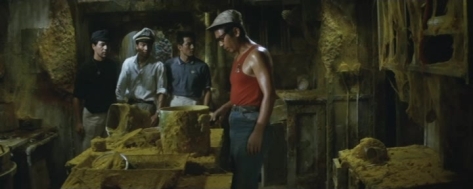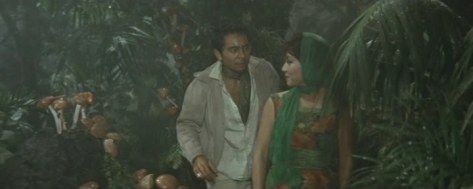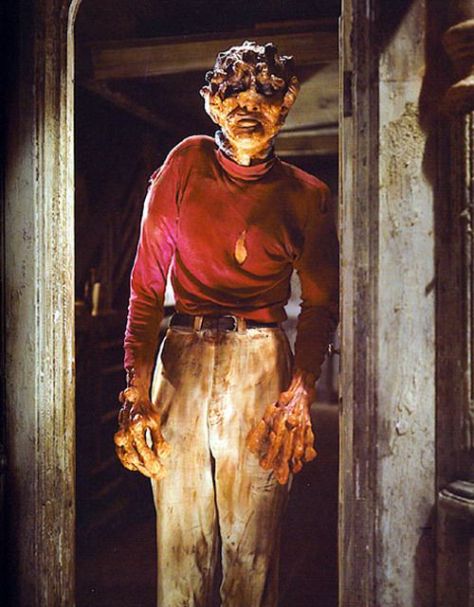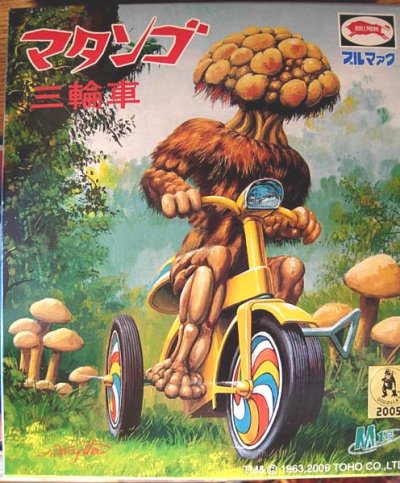
You could very easily argue that a movie like Matango (given the English title Attack of the Mushroom People back in the day) can’t be part of the “new” Creature Canon because it was part of the old one: although never receiving the international popularity of Toho’s kaiju movies, it’s had a following for decades. I know I’ve been reading about this movie for years before actually sitting down and watching it. So maybe this one is a little more well-known then what I usually cover for this, but I see nothing wrong with exploring some of the classics every once in a while.

(Did anyone notice the theme of the last three entries? It’s “non-animal monsters”, and I might not be through with it just yet…)
While directed by Ishiro Honda and utilizing monster suit effects, Matango is a very distinct movie in his oeuvre—and based on the production information I read, that was very intentional. This is an atmospheric thriller, based more on human tension than in waiting for the monster to show up and wreck things, and it’s appropriately given a gloomy colour palette that even infuses greyness into the movie’s verdant tropical setting. The story is based on William Hope Hodgson’s 1907 short story “A Voice in the Night”, a particularly famous example of Hodgson’s influential take on horror, and adapts much of that story’s tone and existential dread. Both the story and the movie root themselves in a creeping desperation for survival, the gradual realization of just how dire the situation is, and the battle to maintain one’s humanity in those circumstances—the monstrous element becomes symbolic of both nature’s hostility, and the way people will sacrifice anything just to stay alive. Despite changing the setting, time period, and the characters involved, the movie maintains those themes, and extends the narrative in ways that carry them even further, and manages to incorporate some from Honda’s other work as well.
(The only evocative element from the story that doesn’t show up in Matango is the victim/narrator thinking that his faith in God will protect him from what’s happening. It’s an effective knife-twist, especially for something written at the turn of the twentieth century.)

Like “Voice in the Night”, the movie is couched in a frame narrative, with the narrator apparently living in a hospital’s psych ward in Tokyo, depicted outside his window as a sprawling sea of skyscrapers and neon lights, an amazing piece of miniatures work by Eiji Tsuburaya and his team. The actual plot starts on the yacht of famous rich guy Kasai (played by Yoshio Tsuchiya, a Toho regular who would later play a Godzilla-obsessed millionaire in Godzilla vs. King Ghidorah), who has invited university professor Murai (the narrator), writer Yoshida (who, in a flashback, defends his propensity for stealing other people’s ideas), singer Mami, and Murai’s student Akiko, alongside the ship’s skipper Naoyuki and his assistant Koyama. This is a day trip party for rich people, drinking and carousing and wearing the brightest sixties fashions, which is interrupted by a storm that destroys the ship’s sails and sets them adrift, their radio battery dying just as they hear a news report about how hopeless their situation is. Eventually, they encounter an island, and go there in search of food and water, finding it completely empty of animal life, but filled with mushrooms that they fear might be poisonous. They then find a beached ship covered in mould, which they learn was a vessel researching the effects of radiation on the environment, and then take it as their shelter. As the limited food supplies begin to dwindle, many of them begin to become desperate, selfish, and violent—Kasai steals food, Koyama makes threatening remarks to the women (and sells Kasai turtle eggs for money), Mami tries to connive ways to make it out on top, and Yoshida begins secretly going out and eating the mushrooms despite the danger. Things really boil over after the ship is visited by a mysterious deformed man in the middle of the night, and while Murai and Akiko plan ways to get off the island, we see just what power the island’s mushrooms (which pulsate and spread during a rainstorm) have.

The conflict between all the castaways is central to most of the narrative, and begins almost at the first sign of trouble—it’s hard to tell if this is meant to comment on the wealth and privilege of most of the characters, but I don’t imagine their positions in life are entirely coincidental (it may also explain why the meek Akiko, who is just a student, feels so removed from everyone else.) It’s a cynical counterpoint to all the stories about survivors of shipwrecks—not only is the possibility of being rescued made to seem utterly remote, but the characters sabotage their means of survival constantly. When they find a gun and ammunition on the abandoned ship, it’s constantly being pulled on everyone else by someone until it gets wrestled away, with the last struggle leading not only to Koyama’s death, but to Yoshida and Mami being banished from the group. The skipper spends most of the story despondent, and then he steals the repaired yacht in a bid to escape, only to run out of supplies and be apparently so overcome with guilt that he jumps off the boat. It’s a grim portrayal, with the sudden appearance of mysterious mutants only making things worse. It’s no wonder that so many of the survivors end up going straight for the mushrooms—at that point, what do they have to lose? For the most part, Murai and Akiko are the only ones who maintain some semblance of composure, but while the weakness of the others is what leads them to become infected earlier on (with Yoshida, whose weak moral fibre and overactive imagination—before they land on the island, he hallucinates a gigantic ship careening towards their yacht—paint him as someone who might crack first), the “heroes” aren’t safe either. By the end of it, it’s definitely not a karmic resolution, as the mushrooms don’t care whose desperation they prey on.

Yes, let’s get to the (American) titular attacking mushroom people. They appear only sporadically through most of the film, usually in shadows or in quick cuts. Sometimes, they appear to be zombie-like, or like deformed humans, but later on there are straight-up walking mushrooms as well—whether those are actually living fungus or the end result of humans infected by it, well, it doesn’t really matter. When one eats the island’s mushrooms, you first get a faintly psychedelic hallucination—in this case, we get to watch a bunch of acrobats tumble around, because that’s apparently the most hallucinatory image they could think of—followed by a strong desire to eat more mushrooms (and convince others to do the same) as it slowly takes over your body. They don’t just solve your hunger problems, but basically solves all your problems completely by removing your humanity and turning you into more fungus. In one of the final scenes, the sheer glee on the characters’ fungus-covered faces as they call to Murai is creepy enough, but when combined with the mushroom monsters themselves and their cacophonous laughter, you have a scene that is genuinely unsettling. I can only imagine how terrified a kid stumbling on this movie on TV decades ago would be—those five or so minutes are truly nightmarish.
Then we get to the ending, with Murai, the only one to get off the island alive, in the hospital talking to a team of doctors, admitting that he should have just stayed, that life in the civilized world isn’t all that much better. Even though we see that he has also been infected with the fungus, he still ends up having a bit of a point. After all, he has witnessed the worst in humanity and now has to live with all his realizations, so happily consuming (and becoming) mobile mushrooms with his love interest forever seems like a far better alternative.

In the original story, the infectious fungus are just a naturally-occurring thing, a menacing organism that lurked in the imaginations of people who still thought there were unmapped territories left in the world. As I mentioned before, Matango briefly invokes radiation as a potential explanation for the mutant mushrooms, but doesn’t really dwell on it, unlike certain other movies in Ishiro Honda’s filmography—but the spectre of atomic weaponry and the effects it has on the environment is still invoked, giving the film’s cynicism all that much more weight. It very subtly changes the story from being about a random bit of scary nature to the side effect of our own activity, transforming our world into something incomprehensible. Apparently, the make-up on the more humanoid of the mushroom people almost got the film banned in Japan, as the censors thought they closely resembled the deformities of survivors of the atomic bombing in World War II—and while the filmmakers probably argued that it was unintentional, I have to imagine that’s not entirely true. It’s the kind of real-life horror that informs the more fantastical kind and makes all the more disturbing.
Matango feels utterly unique in the still fairly early history of Japanese monster movies, incorporating all of the stylish filming and quirks (they’re doing all sorts of experimental editing tricks in this one, which only adds to its unnerving unreality, except for the opening credits, which are fairly silly) while presenting a mostly small-scale and bleak story. It’s a wonderfully directed movie, too, and all the more interesting considering Honda made it between King Kong vs. Godzilla and Mothra vs. Godzilla (and in the same year as Atragon), both of which couldn’t be more different from this in tone. It just goes to show what these filmmakers are capable of, especially when they venture outside into a wider, weirder world.

